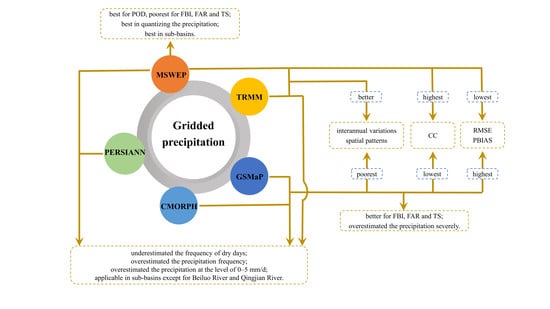Reliability of Gridded Precipitation Products in the Yellow River Basin, China
Abstract
1. Introduction
2. Study Area and Methods
2.1. Study Area
2.2. Datasets
2.3. Methods
3. Results
3.1. Annual Precipitation and Spatial Pattern
3.2. Monthly Precipitation and Annual Distribution
3.3. Daily Precipitation and Precipitation Events
3.4. Frequency Curve of Precipitation
3.5. Applicability in Sub-Regions
4. Discussion
4.1. Differences of Data Sources and Algorithms Among Gridded Precipitation Products
4.2. Results Comparison with Previous Studies
4.3. Hydrological Application of the Gridded Precipitation Products
5. Conclusions
Author Contributions
Funding
Conflicts of Interest
References
- Duncan, M.; Austin, B.; Fabry, F.; Austin, G. The effect of gauge sampling density on the accuracy of streamflow prediction for rural catchments. J. Hydrol. 1993, 142, 445–476. [Google Scholar] [CrossRef]
- Wilk, J.; Kniveton, D.; Andersson, L.; Layberry, R.; Todd, M.C.; Hughes, D.; Ringrose, S.; Vanderpost, C. Estimating rainfall and water balance over the Okavango River Basin for hydrological applications. J. Hydrol. 2006, 331, 18–29. [Google Scholar] [CrossRef]
- Bell, T.; Abdullah, A.; Martin, R.; North, G. Sampling errors for satellite-derived tropical rainfall- Monte Carlo study using a space-time stochastic model. J. Geophys. Res. 1990, 95, 2195–2205. [Google Scholar] [CrossRef]
- Bowman, K.P. Comparison of TRMM precipitation retrievals with rain gauge data from ocean buoys. J. Clim. 2005, 18, 178–190. [Google Scholar] [CrossRef]
- Kummerow, C. Beamfilling errors in passive microwave rainfall retrievals. J. Appl. Meteorol. 1998, 37, 356–370. [Google Scholar] [CrossRef]
- Tian, Y.D.; Peters-Lidard, C.D.; Adler, R.F.; Kubota, T.; Ushio, T. Evaluation of GSMaP precipitation estimates over the contiguous United States. J. Hydrometeorol. 2010, 11, 566–574. [Google Scholar] [CrossRef]
- Li, J.; Heap, A.D. A Review of Spatial Interpolation Methods for Environmental Scientists; Geoscience Australia: Canberra, Australia, 2008.
- Scheel, M.L.M.; Rohrer, M.; Huggel, C.; Santos Villar, D.; Silvestre, E.; Huffman, G.J. Evaluation of TRMM Multi-satellite Precipitation Analysis (TMPA) performance in the Central Andes region and its dependency on spatial and temporal resolution. Hydrol. Earth Syst. Sci. Discuss. 2011, 15, 2649–2663. [Google Scholar] [CrossRef]
- Duethmann, D.; Zimmer, J.; Gafurov, A.; Güntner, A.; Merz, B.; Vorogushyn, S. Evaluation of areal precipitation estimates based on downscaled reanalysis and station data by hydrological modelling. Hydrol. Earth Syst. Sci. Discuss. 2012, 9, 10719–10773. [Google Scholar] [CrossRef]
- Tobin, C.; Nicotina, L.; Parlange, M.B.; Berne, A.; Rinaldo, A. Improved interpolation of meteorological forcings for hydrologic applications in a Swiss Alpine region. J. Hydrol. 2011, 401, 77–89. [Google Scholar] [CrossRef]
- Beck, H.E.; Vergopolan, N.; Pan, M.; Levizzani, V.; Van Dijk, A.; Weedon, G.P.; Brocca, L.; Huffman, G.J.; Wood, E.F.; William, L. Global-scale evaluation of 22 precipitation datasets using gauge observations and hydrological modeling. Hydrol. Earth Syst. Sci. Discuss. 2017, 21, 1–23. [Google Scholar] [CrossRef]
- Cheng, L.; Shen, R.P.; Shi, C.X.; Bai, L.; Yang, Y.H. Evaluation and verification of CMORPH and TRMM 3B42 precipitation estimation products. Meteorological 2014, 40, 1372–1379. [Google Scholar]
- Guo, H.; Chen, S.; Bao, A.M.; Hu, J.J.; Yang, B.H.; Stepanian, P. Comprehensive Evaluation of High-Resolution Satellite-Based Precipitation Products over China. Atmosphere 2016, 7, 6. [Google Scholar] [CrossRef]
- Li, C.M.; Tang, G.Q.; Hong, Y. Cross-Evaluation of Ground-based, Multi-Satellite and Reanalysis Precipitation Products: Applicability of the Triple Collocation Method across Mainland China. J. Hydrol. 2018, 562, 71–83. [Google Scholar] [CrossRef]
- Zhao, H.G.; Yang, B.G.; Yang, S.T.; Huang, Y.C.; Dong, G.T.; Bai, J.; Wang, Z.W. Systematical estimation of GPM-based global satellite mapping of precipitation products over China. Atmos. Res. 2018, 201, 206–217. [Google Scholar] [CrossRef]
- Zhu, Q.; Xuan, W.D.; Liu, L.; Xu, Y.P. Evaluation and hydrological application of precipitation estimates derived from PERSIANN-CDR, TRMM 3B42V7 and NCEP-CFSR over humid regions in China. Hydrol. Process. 2016, 30, 3061–3083. [Google Scholar] [CrossRef]
- Zhang, S.J.; Wang, D.H.; Qin, Z.K.; Zheng, Y.Y.; Guo, J.P. Assessment of the GPM and TRMM Precipitation Products Using the Rain Gauge Network over the Tibetan Plateau. J. Meteorol. Res. 2018, 32, 324–336. [Google Scholar] [CrossRef]
- Gao, Y.C.; Liu, M.F. Evaluation of high-resolution satellite precipitation products using rain gauge observations over the Tibetan Plateau. Hydrol. Earth Syst. Sci. Discuss. 2013, 17, 837–849. [Google Scholar] [CrossRef]
- Tong, K.; Su, F.G.; Yang, D.Q.; Hao, Z.C. Evaluation of satellite precipitation retrievals and their potential utilities in hydrologic modeling over the Tibetan Plateau. J. Hydrol. 2014, 519, 423–437. [Google Scholar] [CrossRef]
- Zhu, H.L.; Li, Y.; Huang, Y.W.; Li, Y.C.; Hou, C.C.; Shi, X.L. Evaluation and hydrological application of satellite-based precipitation datasets in driving hydrological models over the Huifa river basin in Northeast China. Atmos. Res. 2018, 207, 28–41. [Google Scholar] [CrossRef]
- Chen, C.; Chen, Q.W.; Duan, Z.; Zhang, J.Y.; Mo, K.L.; Li, Z.; Tang, G.Q. Multiscale Comparative Evaluation of the GPM IMERG v5 and TRMM 3B42 v7 Precipitation Products from 2015 to 2017 over a Climate Transition Area of China. Remote Sens. 2018, 10, 944. [Google Scholar] [CrossRef]
- Gao, F.; Zhang, Y.H.; Chen, Q.H.; Wang, P.; Yang, H.R.; Yao, Y.J.; Cai, W.Y. Comparison of two long-term and high-resolution satellite precipitation datasets in Xinjiang, China. Atmos. Res. 2018, 212, 150–157. [Google Scholar] [CrossRef]
- Deng, Y.; Jiang, W.G.; Wang, X.Y.; Lyu, J.X. Accuracy assessment of MSWEP over mainland China. Adv. Water Sci. 2018, 29, 455–464. (In Chinese) [Google Scholar]
- Miao, C.Y.; Ashouri, H.; Hsu, K.L.; Sorooshian, S.; Duan, Q.Y. Evaluation of the PERSIANN-CDR Daily Rainfall Estimates in Capturing the Behavior of Extreme Precipitation Events over China. J. Hydrometeorol. 2015, 16, 1387–1396. [Google Scholar] [CrossRef]
- Liu, X.M.; Yang, T.T.; Hsu, K.L.; Liu, C.M.; Sorooshian, S. Evaluating the streamflow simulation capability of PERSIANN-CDR daily rainfall products in two river basins on the Tibetan Plateau. Hydrol. Earth Syst. Sci. Discuss. 2017, 21, 1–31. [Google Scholar] [CrossRef]
- Li, Q.L.; Zhang, W.C.; Yi, L.; Liu, J.P.; Chen, H. Accuracy evaluation and comparison of GPM and TRMM precipitation product over Mainland China. Adv. Water Sci. 2018, 29, 303–313. (In Chinese) [Google Scholar]
- Collischonn, B.; Collischonn, W.; Tucci, C.E.M. Daily hydrological modeling in the Amazon basin using TRMM rainfall estimates. J. Hydrol. 2008, 360, 207–216. [Google Scholar] [CrossRef]
- Dong, G.T.; Fan, D.; Yang, S.T.; Xue, H.Z.; Zhou, J.L.; Dang, S.Z.; Cheng, C.X. Analysis on the Applicability of GPM and TRMM Precipitation Data in the Yellow River Basin. Res. Soil Water Conserv. 2018, 25, 81–87. (In Chinese) [Google Scholar]
- Li, F.X.; Chen, D.; Tang, Q.H. Variations of hydro-meteorological variables in the Yellow River basin and their relationships with the East Asian summer monsoon. Adv. Water Sci. 2015, 26, 481–490. (In Chinese) [Google Scholar]
- Mai, M.; Zeng, Y.; Qiu, X.F. Variation of Sunshine Percentage for the Last 40 Years in the Yellow River Basin. Meteorological 2006, 32, 62–66. (In Chinese) [Google Scholar]
- He, J.P.; He, Z. Spatio-temporal characteristics of extreme precipitation event in Yellow River basin in recent 53 a. Ecol. Environ. Sci. 2014, 23, 95–100. (In Chinese) [Google Scholar]
- Wu, J.; Gao, X.J. A gridded daily observation dataset over China region and comparison with the other datasets. Chin. J. Geophys. 2013, 56, 1102–1111. (In Chinese) [Google Scholar]
- New, M.; Lister, D.; Hulme, M. A high-resolution data set of surface climate over global land areas. Clim. Res. 2002, 21, 1–25. [Google Scholar] [CrossRef]
- Xie, P.P.; Yatagai, A.; Chen, M.Y.; Hayasaka, T.; Fukushima, Y.; Liu, C.M.; Yang, S. A Gauge-based analysis of daily precipitation over East Asia. J. Hydrometeorol. 2007, 8, 607–626. [Google Scholar] [CrossRef]
- Xu, Y.; Gao, X.J.; Shen, Y.; Xu, C.; Shi, Y.; Giorgi, F. A daily temperature dataset over China and its application in validating a RCM simulation. Adv. Atmos. Sci. 2009, 26, 763–772. [Google Scholar] [CrossRef]
- Yatagai, A.; Arakawa, O.; Kamiguchi, K. A 44-year daily gridded precipitation dataset for Asia based on a dense network of rain gauges. SOLA 2009, 5, 137–140. [Google Scholar] [CrossRef]
- Zhao, Z.P.; Liu, J.Y.; Shao, Q.Q. Spatial diversity of humidification and its impact on ecosystem venerability in China during the last 30 years. J. Nat. Resour. 2010, 25, 2091–2100. (In Chinese) [Google Scholar]
- Gribbon, K.T.; Bailey, D.G. A Novel Approach to Real-time Bilinear Interpolation. In Proceedings of the Second IEEE International Workshop on Electronic Design, Test and Applications, Perth, Australia, 28–30 January 2004; p. 126. [Google Scholar]
- Ji, X.; Chen, Y.F. Characterizing spatial patterns of precipitation based on corrected TRMM 3B43 data over the mid Tianshan Mountains of China. J. Mt. Sci. 2012, 9, 628–645. [Google Scholar] [CrossRef]
- Joyce, R.J.; Janowiak, J.E.; Arkin, P.A.; Xie, P. CMORPH: A method that produces global precipitation estimates from passive microwave and infrared data at high spatial and temporal resolution. J. Hydrometeorol. 2004, 5, 487–503. [Google Scholar] [CrossRef]
- Shen, Y.; Zhao, P.; Pan, Y.; Yu, J.J. A high spatiotemporal gauge-satellite merged precipitation analysis over China. J. Geophys. Res. Atmos. 2014, 119, 3063–3075. [Google Scholar] [CrossRef]
- Ashouri, H.; Hsu, K.L.; Sorooshian, S.; Dan, K.B.; Knapp, K.R.; Cecil, L.D.; Nelson, B.R.; Prat, O.P. PERSIANN-CDR: Daily Precipitation Climate Data Record from Multisatellite Observations for Hydrological and Climate Studies. Bull. Am. Meteorol. Soc. 2014, 96, 197–210. [Google Scholar] [CrossRef]
- Huffman, G.J.; Bolvin, D.T.; Nelkin, E.J.; Wolff, D.B.; Adler, R.F.; Gu, G.; Hong, Y.; Bowman, K.P.; Stocker, E.F. The TRMM multisatellite precipitation analysis (TMPA): Quasi-global, multiyear, combined-sensor precipitation estimates at fine scales. J. Hydrometeorol. 2007, 8, 38–55. [Google Scholar] [CrossRef]
- Iguchi, T.; Kozu, T.; Kwiatkowski, J.; Meneghini, R.; Awaka, J.; Okamoto, K. A Kalman filter approach to the Global Satellite Mapping of Precipitation (GSMaP) from combined passive microwave and infrared radiometric data. J. Meteorol. Soc. Jpn. 2009, 87A, 137–151. [Google Scholar]
- Beck, H.E.; Van Dijk, A.I.J.M.; Levizzani, V.; Schellekens, J.; Miralles, D.G.; Martens, B.; De Roo, A. MSWEP: 3-hourly 0.25° global gridded precipitation (1979–2015) by merging gauge, satellite, and reanalysis data. Hydrol. Earth Syst. Sci. 2017, 21, 1–38. [Google Scholar] [CrossRef]
- Condom, T.; Rau, P.; Espinoza, J.C. Correction of TRMM 3B43 monthly precipitation data over the mountainous areas of Peru during the period 1998–2007. Hydrol. Process. 2011, 25, 1924–1933. [Google Scholar] [CrossRef]
- Brown, J.E.M. An analysis of the performance of hybrid infrared and microwave satellite precipitation algorithms over India and adjacent regions. Remote Sens. Environ. 2006, 101, 63–81. [Google Scholar] [CrossRef]
- Su, F.G.; Gao, H.L.; Huffman, G.J.; Lettenmaier, D.P. Potential utility of the real-time TMPA-RT precipitation estimates in streamflow prediction. J. Hydrometeorol. 2011, 12, 444–455. [Google Scholar] [CrossRef]
- Su, F.G.; Hong, Y.; Lettenmaier, D.P. Evaluation of TRMM Multisatellite Precipitation Analysis (TMPA) and its utility in hydrologic prediction in the La Plata Basin. J. Hydrometeorol. 2008, 9, 622–640. [Google Scholar] [CrossRef]
- Wilks, D.S. Statistical Methods in the Atmospheric Sciences: An Introduction; Academic Press: New York, NY, USA, 1995. [Google Scholar]
- Shen, Y.; Hong, Z.; Pan, Y.; Yu, J.J.; Maguire, L. China’s 1 km Merged Gauge, Radar and Satellite Experimental Precipitation Dataset. Remote Sens. 2018, 10, 264. [Google Scholar] [CrossRef]
- Xu, Z.X.; Zhang, N. Long-term trend of precipitation in the Yellow River basin during the past 50 years. Geogr. Res. 2006, 25, 27–34. (In Chinese) [Google Scholar]
- Ke, S.J.; Wang, L. Analysis of the Precipitation Law in the Yellow River Basin. Yellow River 1997, 7, 18–22. (In Chinese) [Google Scholar]
- Knapp, K.R. Scientific data stewardship of international satellite cloud climatology project B1 global geostationary observations. J. Appl. Remote Sens. 2008, 2, 142–154. [Google Scholar] [CrossRef]
- Sorooshian, S.; Hsu, K.L.; Ashouri, H.; Braithwaite, D.; Nguyen, P.; Thorstensen, A.R. PERSIANN-CDR Daily Precipitation Dataset for Hydrologic Applications and Climate Studies. In Proceedings of the AGU Fall Meeting, San Francisco, CA, USA, 14–18 December 2015. [Google Scholar]
- Joyce, R.J.; Xie, P.P. Kalman Filter-Based CMORPH. J. Hydrometeorol. 2011, 12, 1547–1563. [Google Scholar] [CrossRef]
- Mccollum, J.R.; Krajewski, W.F.; Ferraro, R.R.; Ba, M.B. Evaluation of Biases of Satellite Rainfall Estimation Algorithms over the Continental United States. J. Appl. Meteorol. 2002, 41, 1065–1080. [Google Scholar] [CrossRef]
- Liu, J.; Shangguan, D.; Liu, S.Y.; Ding, Y.J.; Wang, S.P.; Wang, X.N. Evaluation and comparison of CHIRPS and MSWEP daily-precipitation products in the Qinghai-Tibet Plateau during the period of 1981–2015. Atmos. Res. 2019, 230, 104634. [Google Scholar] [CrossRef]
- Liu, J.F.; Chen, R.S.; Han, C.T.; Tan, C.P. Evaluating TRMM multi-satellite precipitation analysis using gauge precipitation and MODIS snow-cover products. Adv. Water Sci. 2010, 21, 343–348. (In Chinese) [Google Scholar]
- Wang, S.X.; Zhang, L.P.; Yu, X.Y.; She, D.X.; Gan, Y.Y. Application of Remote Sensing Precipitation Products in Runoff Simulation over the Lancang River Basin. Resour. Environ. Yangtze Basin 2019, 28, 1365–1374. (In Chinese) [Google Scholar]
- Deng, X.X.; Ye, A.Z.; Mao, Y.; Lang, Y.; Xu, J. TRMM Precipitation Evaluation for Inland of China. J. China Hydrol. 2015, 35, 47–54. (In Chinese) [Google Scholar]
- Luo, S.; Miao, J.F.; Niu, T.; Wei, C.X.; Wang, X. A Comparison of TRMM 3B42 Products with Rain Gauge Observations in China. Meteorol. Mon. 2011, 37, 1081–1090. (In Chinese) [Google Scholar]
- Hu, Q.F.; Yang, D.W.; Wang, Y.; Yang, H.B. Accuracy and spatio-temporal variation of high resolution satellite rainfall estimate over the Ganjiang River Basin. Sci. China 2013, 56, 853–865. [Google Scholar] [CrossRef]
- Cheng, K.Y.; Zhang, L.L.; Kang, Y.; Zhang, J.Y.; Liu, G.B.; Shen, X.Q. Applicability Analysis of Various Satellite-based Precipitation in Oujiang Basin. Water Resour. Power 2016, 34, 15–19. (In Chinese) [Google Scholar]
- Li, R.Z.; Zhang, A.D.; Zhang, H.; Jiang, D.J. Accuracy evaluation of multi-satellite precipitation products over Circum-Bohai-Sea Region. Chin. J. Appl. Ecol. 2016, 27, 2916–2924. (In Chinese) [Google Scholar]
- Wei, L.Y.; Jiang, S.H.; Ren, L.L.; Zhang, L.Q.; Zhou, M.Y. Evaluation and Comparison of Multi-Source Satellite Precipitation Products in Different Climate Regions over Mainland China. China Rural Water Hydropower 2019, 0, 38–44. (In Chinese) [Google Scholar]
- Wang, Y.D.; Chen, H.; Liu, C.R.; Ding, Y.J. Applicability of ITPCAS and CMORPH Precipitation Datasets over Shaanxi Province. Arid Zone Res. 2018, 35, 579–588. (In Chinese) [Google Scholar]
- Xu, S.G.; Niu, Z.; Shen, Y.; Da, K. A Research into the Characters of CMORPH Remote Sensing Precipitation Error in China. Remote Sens. Technol. Appl. 2014, 29, 189–194. (In Chinese) [Google Scholar]
- Xu, S.G.; Niu, Z.; Shen, Y.; Kuang, D. Evaluation and Modification of CMORPH Multi-satellite Precipitation Estimates in Summer over Tibetan Plateau. Remote Sens. Inf. 2015, 30, 71–76. (In Chinese) [Google Scholar]
- Jin, X.L.; Shao, H.; Zhang, C.; Yan, Y. The Applicability Evaluation of Three Satellite Products in Tianshan Mountains. J. Nat. Resour. 2016, 31, 2074–2085. (In Chinese) [Google Scholar]
- Gao, Y.; Xu, H.; Guo, L. Evaluation of the GSMaP Estimates on Monitoring Extreme Precipitation Events. Remote Sens. Technol. Appl. 2019, 34, 1121–1132. [Google Scholar]
- Zeng, S.K.; Yong, B. Evaluation of the GPM-based IMERG and GSMaP precipitation estimates over the Sichuan region. Acta Geogr. Sin. 2019, 74, 1305–1318. (In Chinese) [Google Scholar]
- Fu, Q.N.; Ruan, R.Z.; Liu, Y.B. Accuracy Assessment of Global Satellite Mapping of Precipitation (GSMaP) Product over Poyang Lake Basin, China. Procedia Environ. Sci. 2011, 10, 2265–2271. [Google Scholar] [CrossRef]
- Zhou, X.; Ni, G.H.; Zhong, Z.Y.; Guo, S. Evaluation of Accuracy and Streamflow Simulation of TRMM Satellite Precipitation Data. J. Water Resour. Res. 2019, 8, 125–135. (In Chinese) [Google Scholar] [CrossRef]
- Siddique-E-Akbor, A.H.M.; Hossain, F.; Sikder, S. Satellite Precipitation Data–Driven Hydrological Modeling for Water Resources Management in the Ganges, Brahmaputra, and Meghna Basins. Earth Interact. 2014, 18, 1–25. [Google Scholar] [CrossRef]
- Tam, T.H.; Rahman, A.M.Z. Application of Satellite Rainfall Products for Flood Inundation Modelling in Kelantan River Basin, Malaysia. Hydrology 2019, 6, 95. [Google Scholar] [CrossRef]
- Mazzoleni, M.; Bhattacharya, B.; Barajas, M.A.L. Exploring the use of the three rainfall remote sensing products for flood prediction in the Brahmaputra basin. EPiC Ser. Eng. 2018, 3, 1366–1372. [Google Scholar]
- Fallah, A.; Orth, R. Climate-dependent propagation of precipitation uncertainty into the water cycle. Hydrol. Earth Syst. Sci. 2020. discussed manuscript. [Google Scholar]
- López, P.L.; Sutanudjaja, E.H.; Schellekens, J.; Sterk, G.; Bierkens, M.F. Calibration of a large-scale hydrological model using satellite-based soil moisture and evapotranspiration products. Hydrol. Earth Syst. Sci. 2017, 21, 3125–3144. [Google Scholar] [CrossRef]
- Shrestha, A.; Nair, A.S.; Indu, J. Role of precipitation forcing on the uncertainty of land surface model simulated soil moisture estimates. J. Hydrol. 2020, 580, 124264. [Google Scholar] [CrossRef]
- Xu, Z.; Wu, Z.; He, H. Evaluating the accuracy of MSWEP V2. 1 and its performance for drought monitoring over mainland China. Atmos. Res. 2019, 226, 17–31. [Google Scholar] [CrossRef]
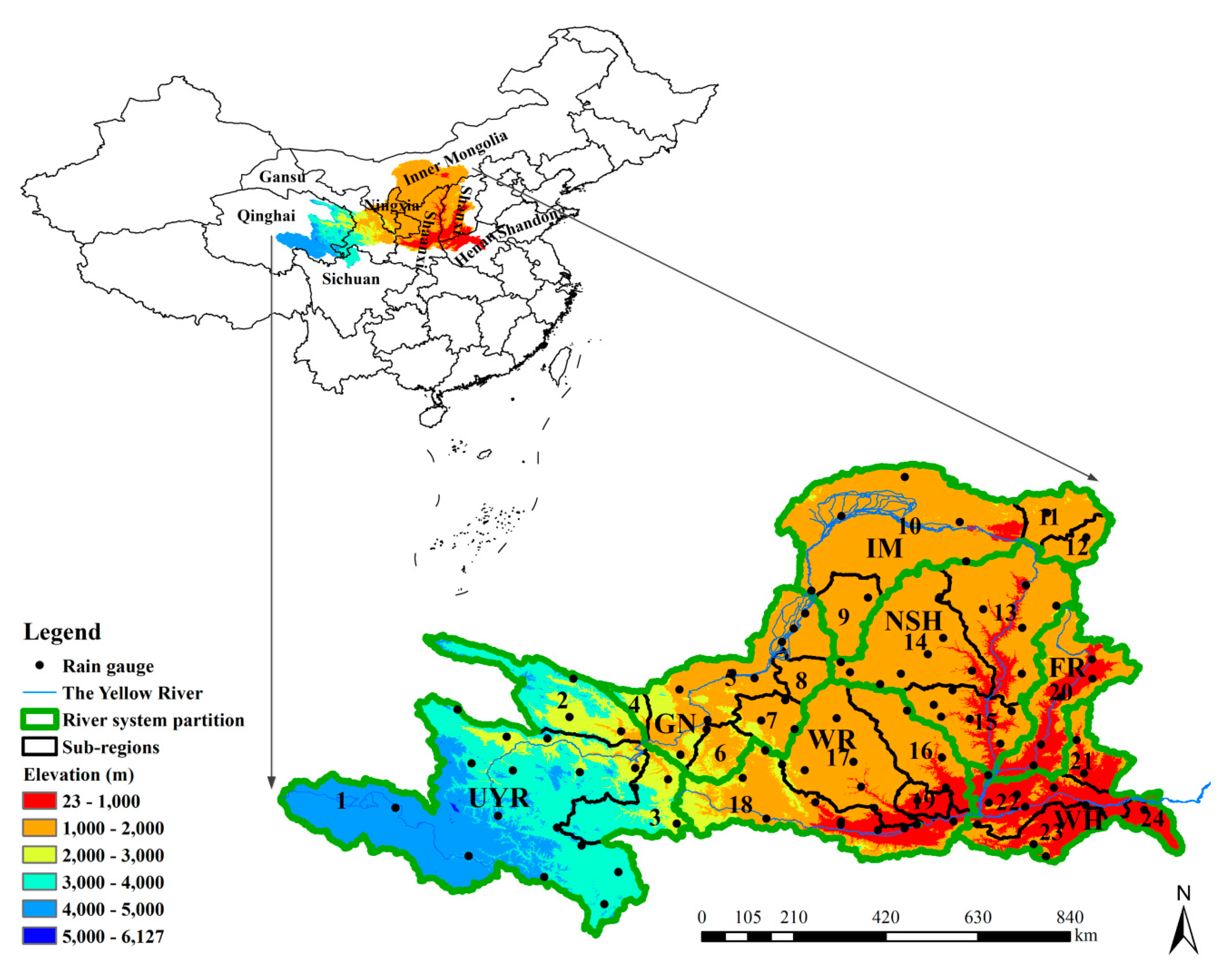

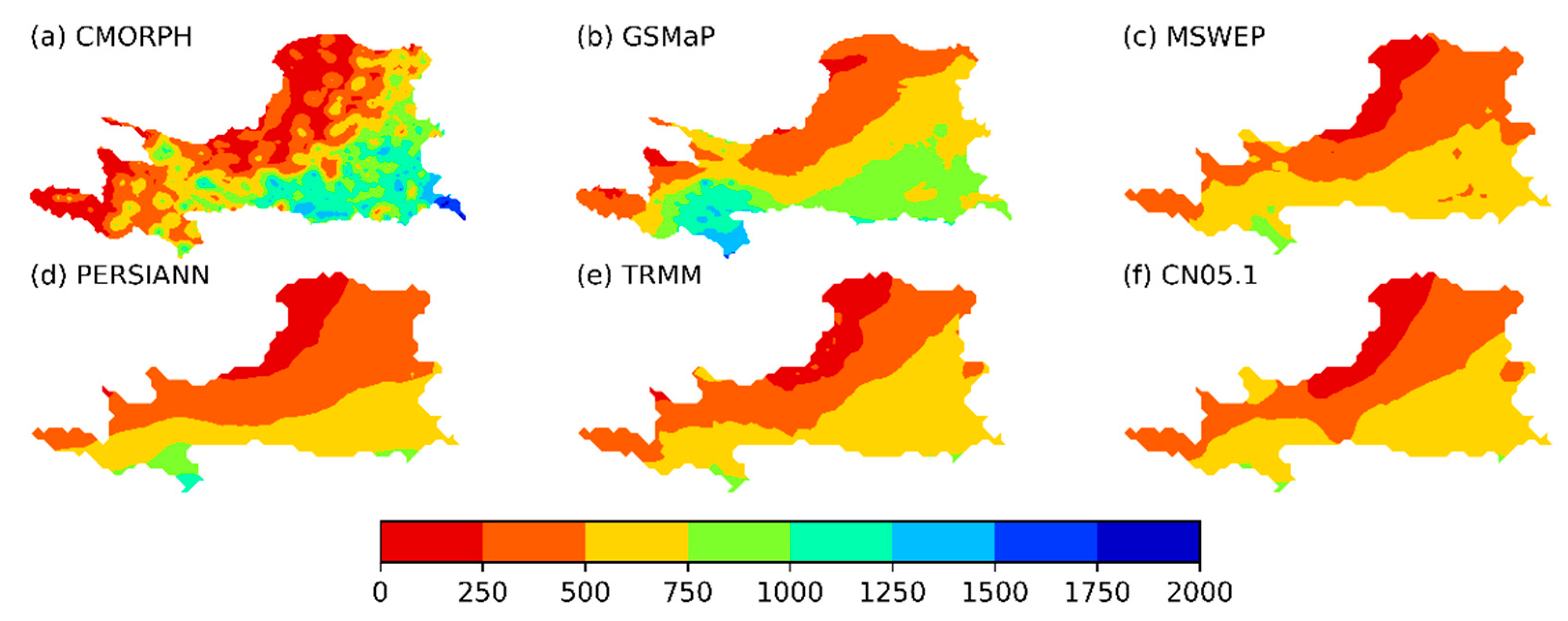
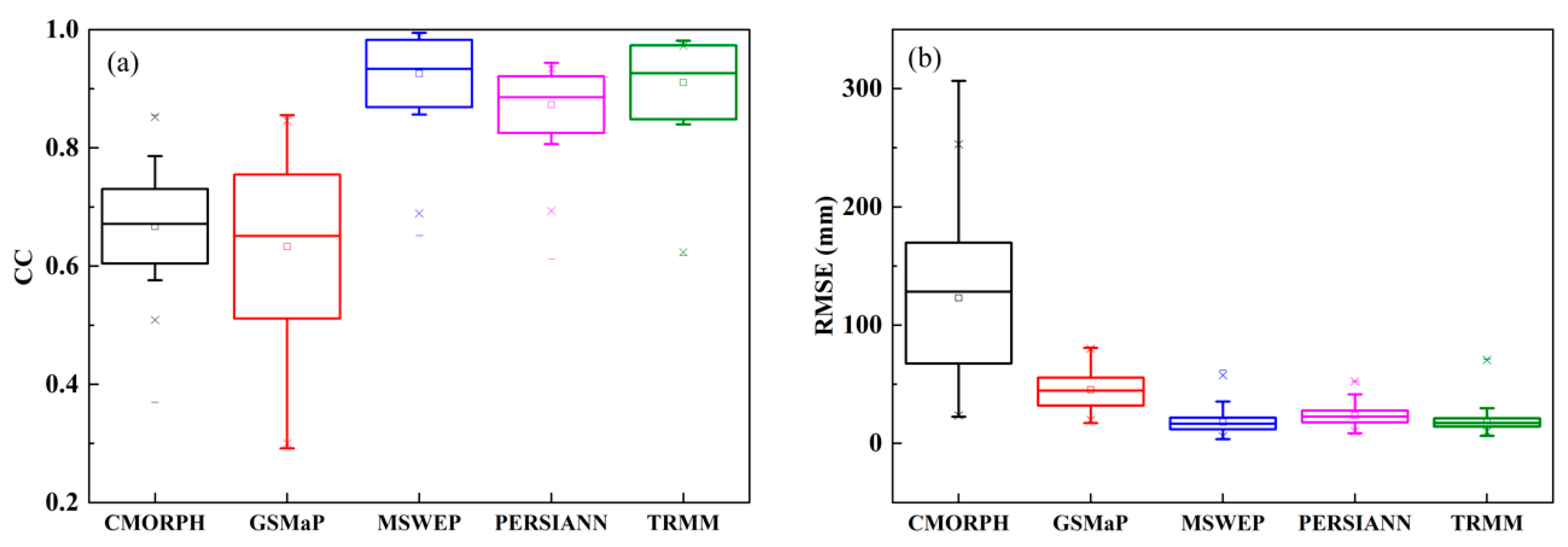

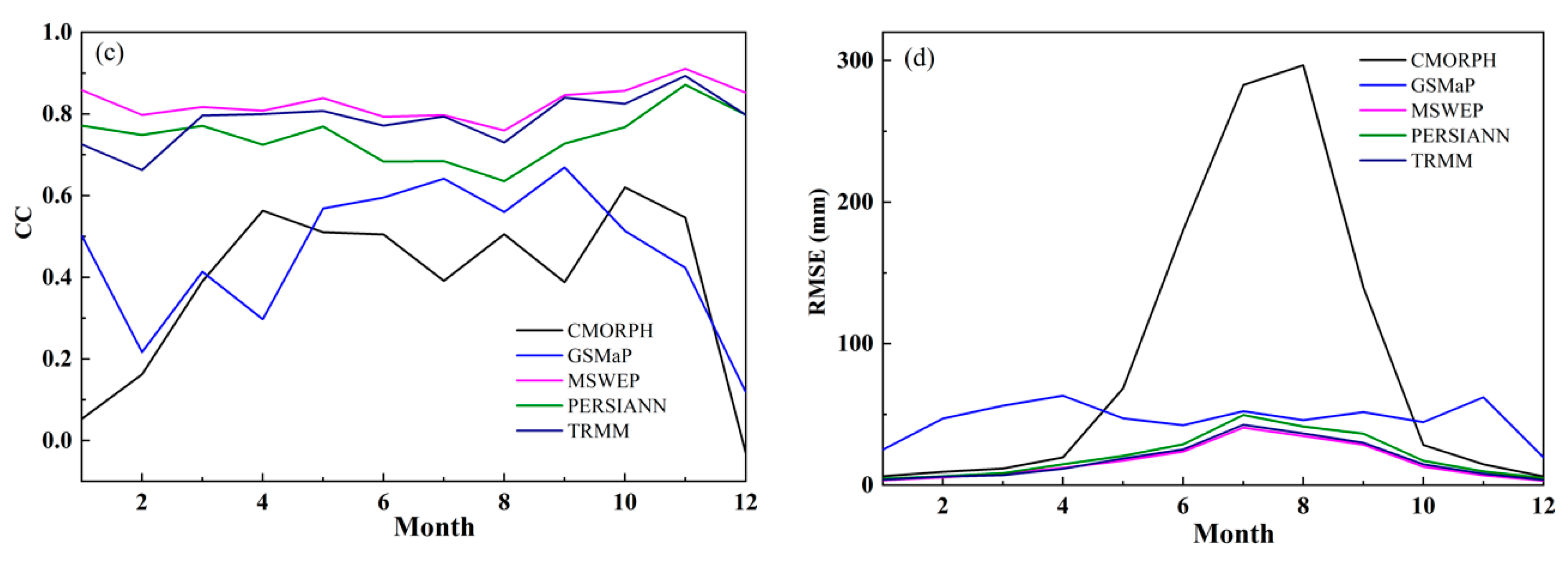
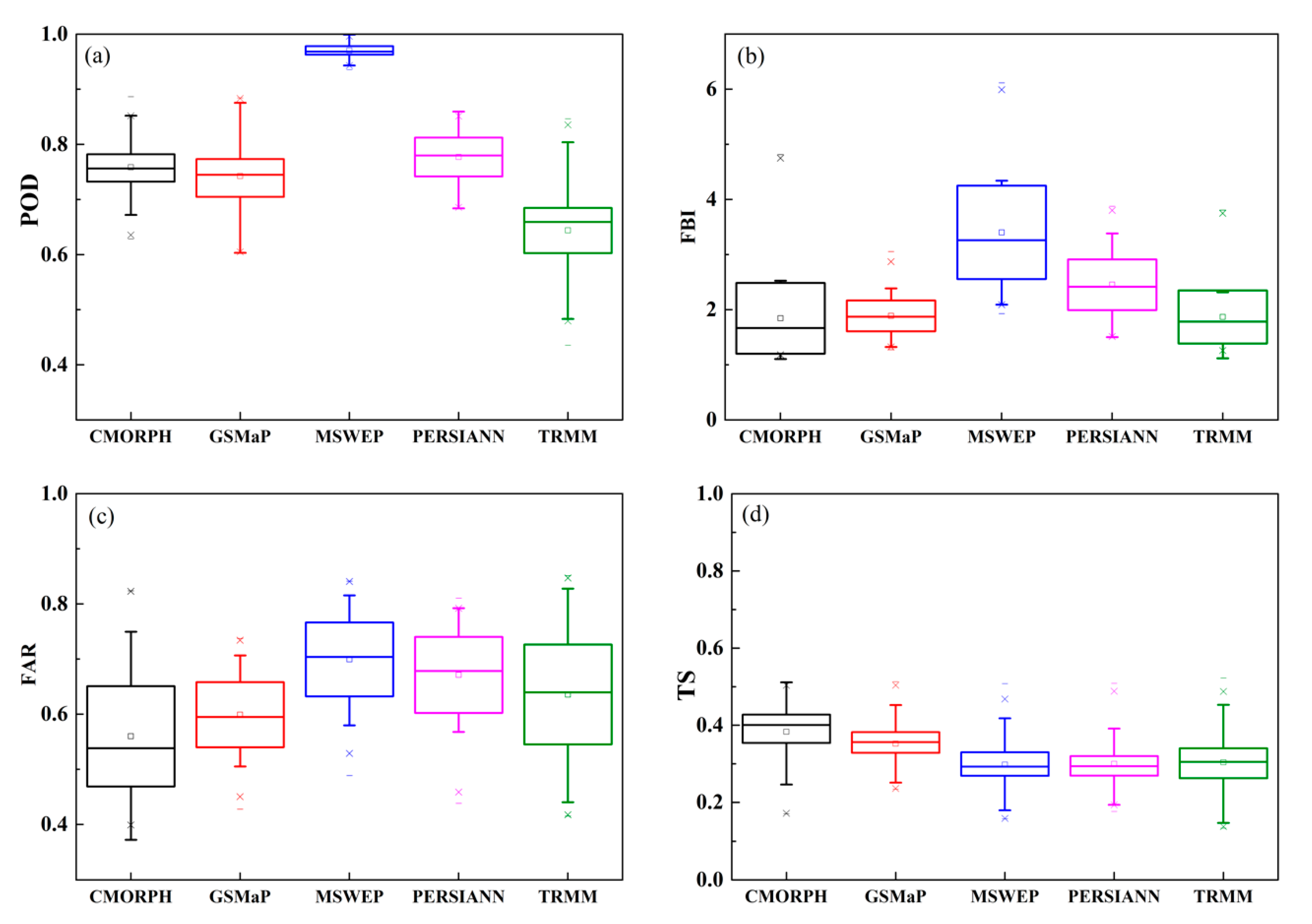

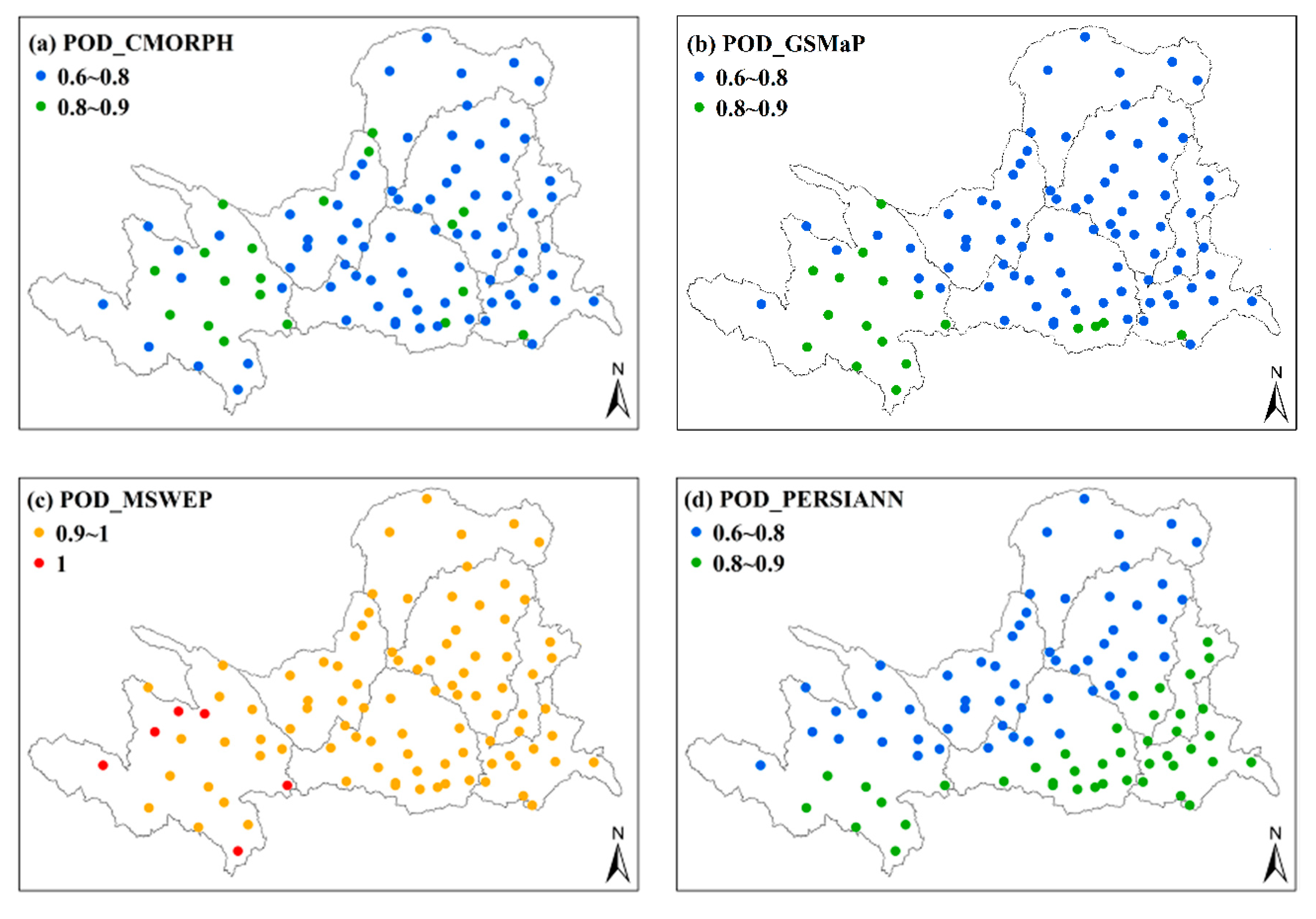
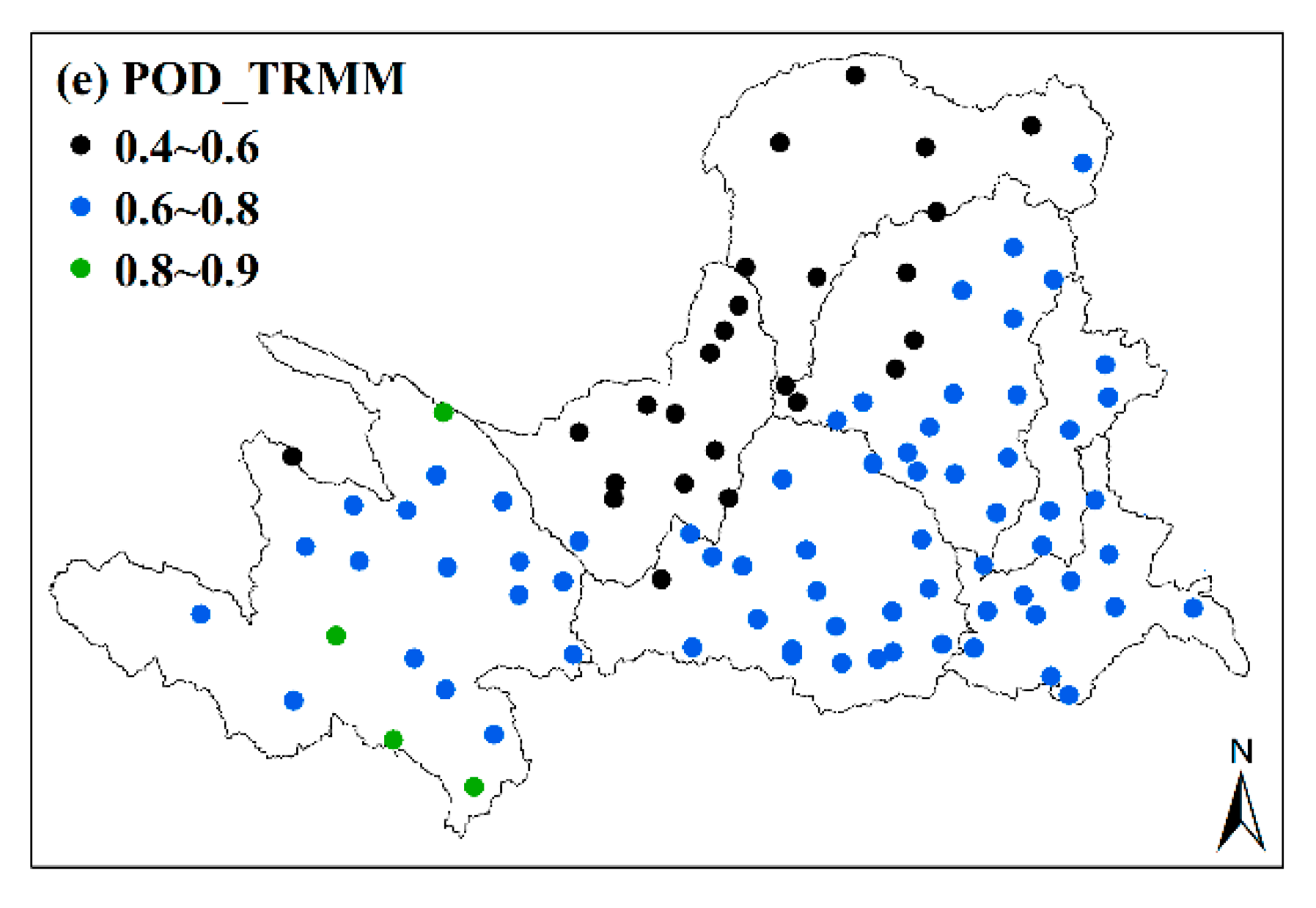


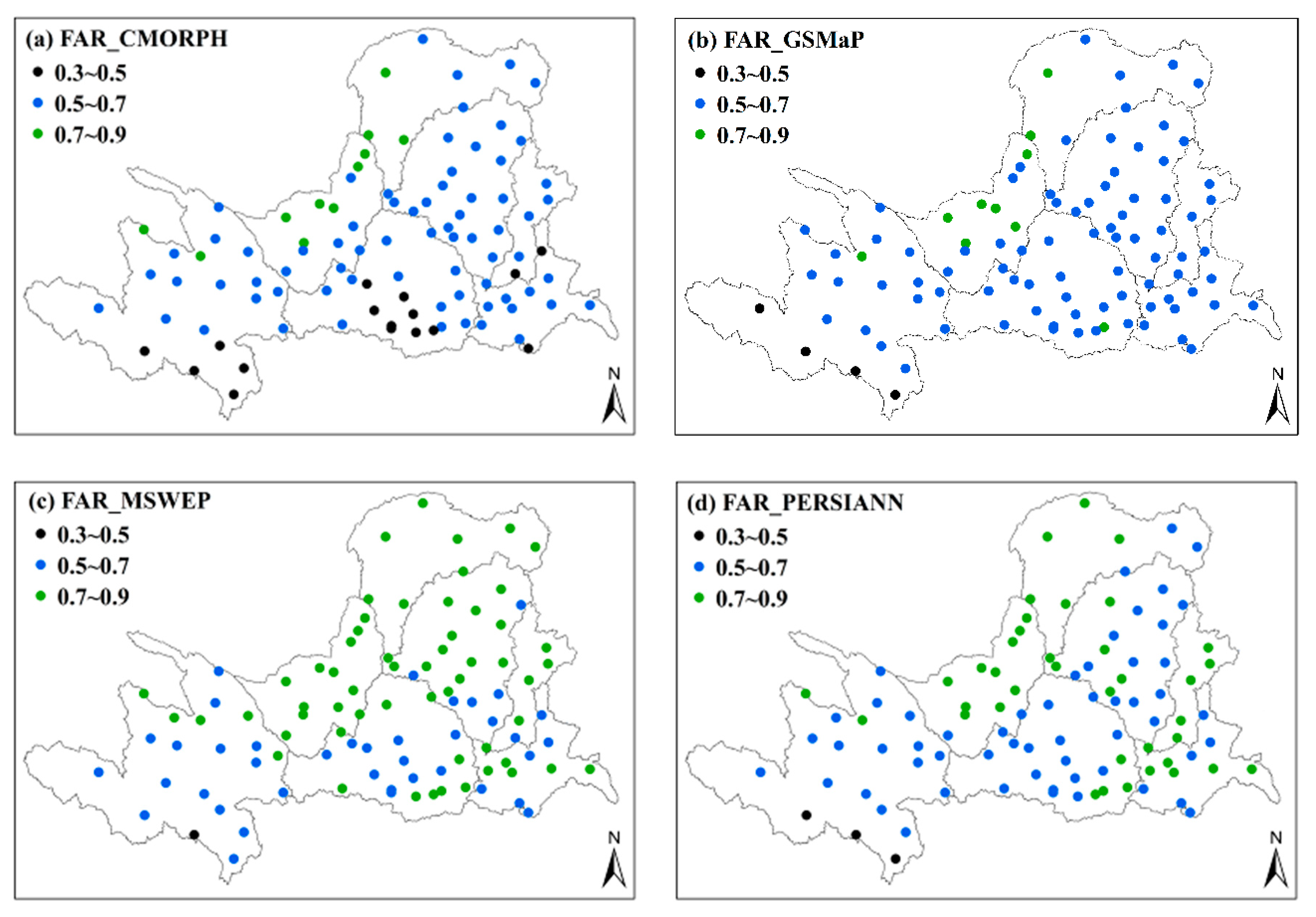
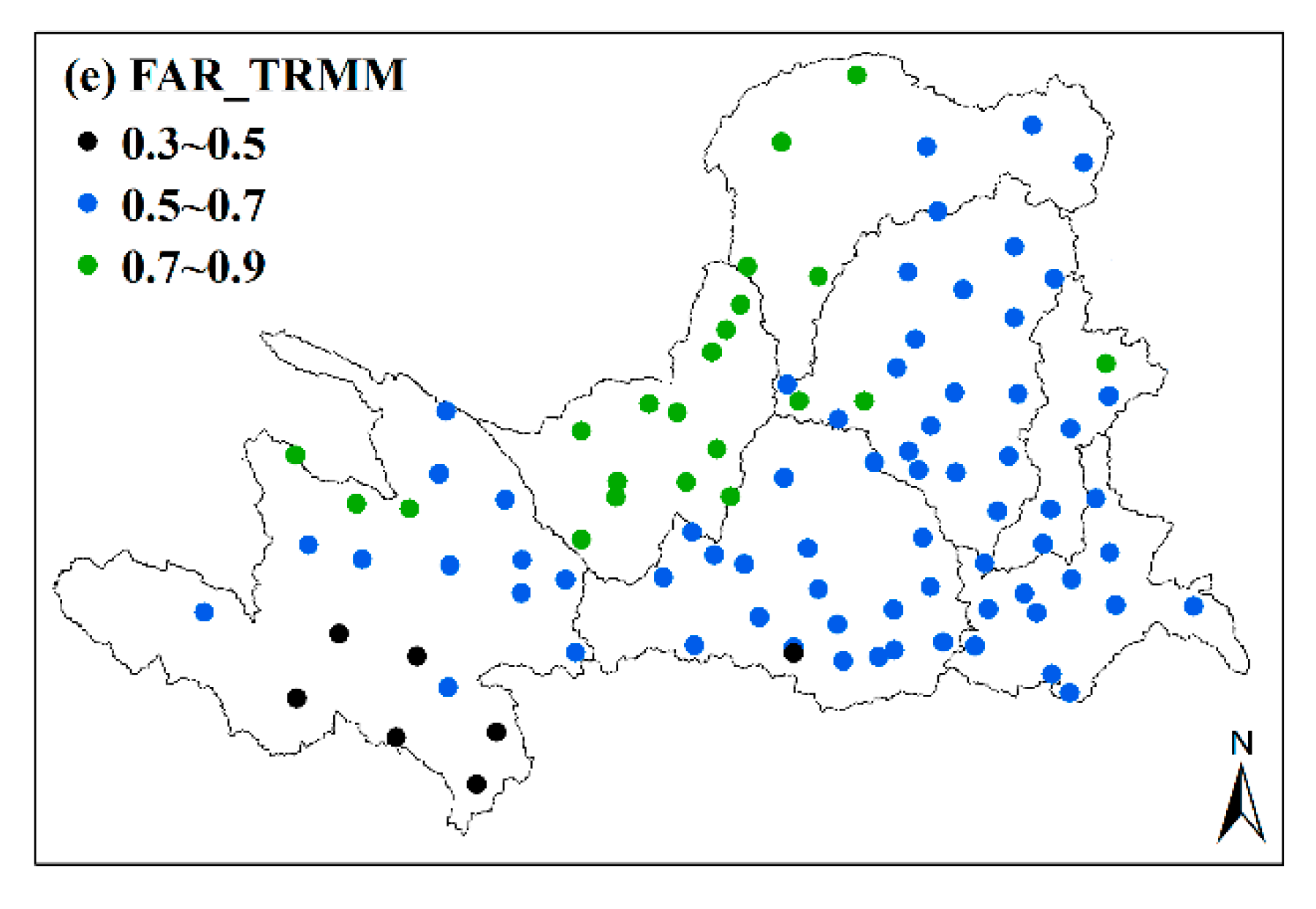
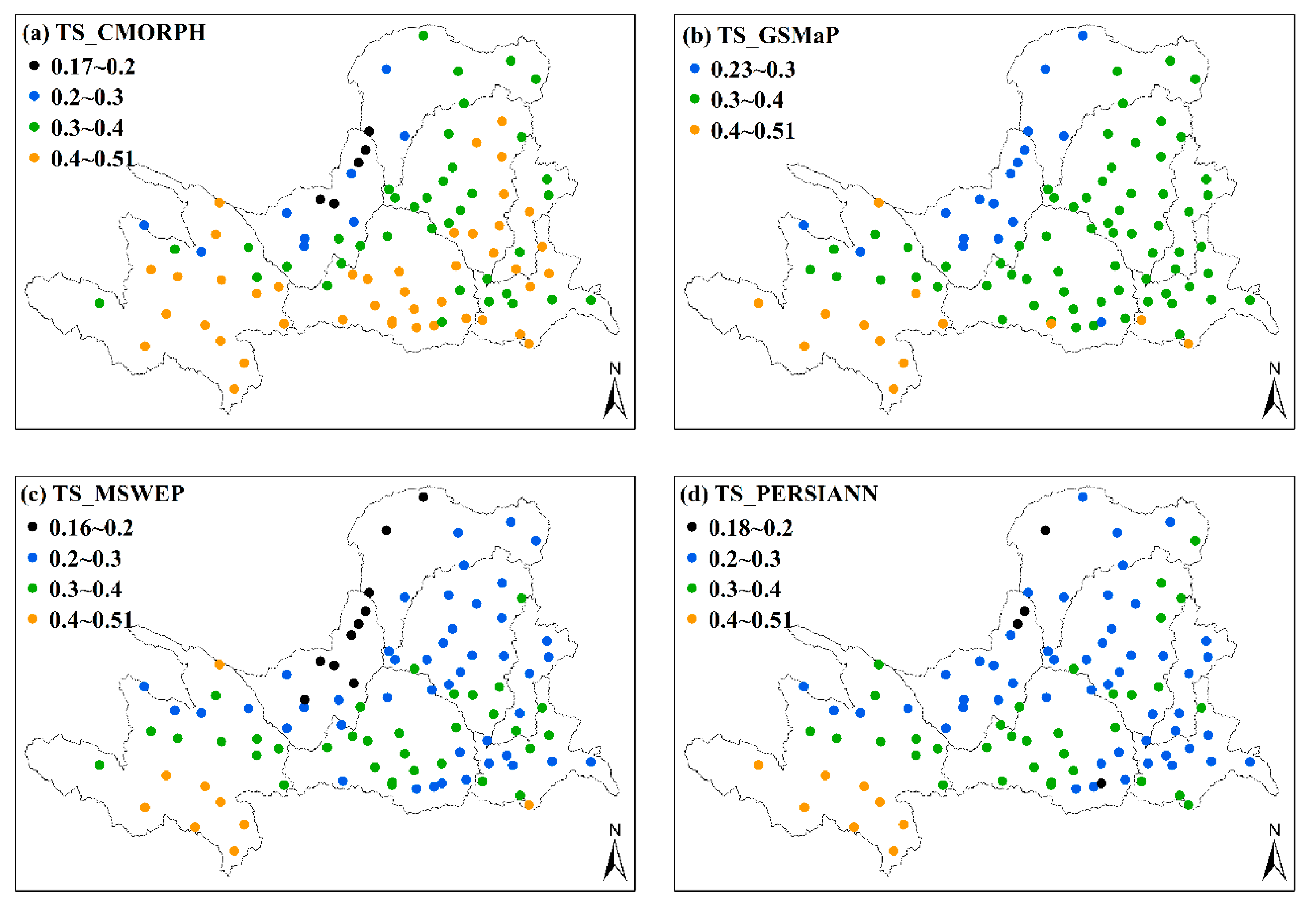

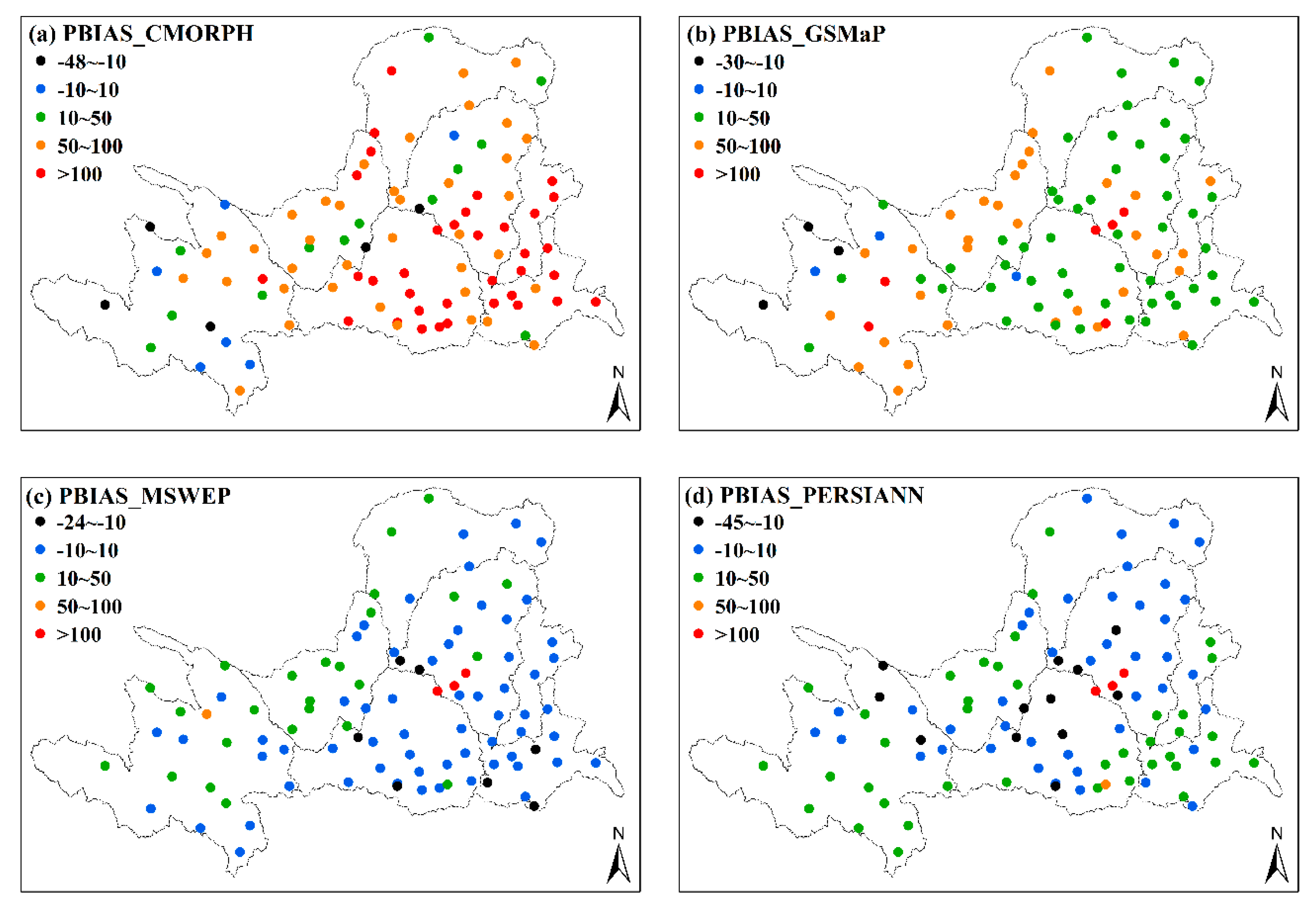
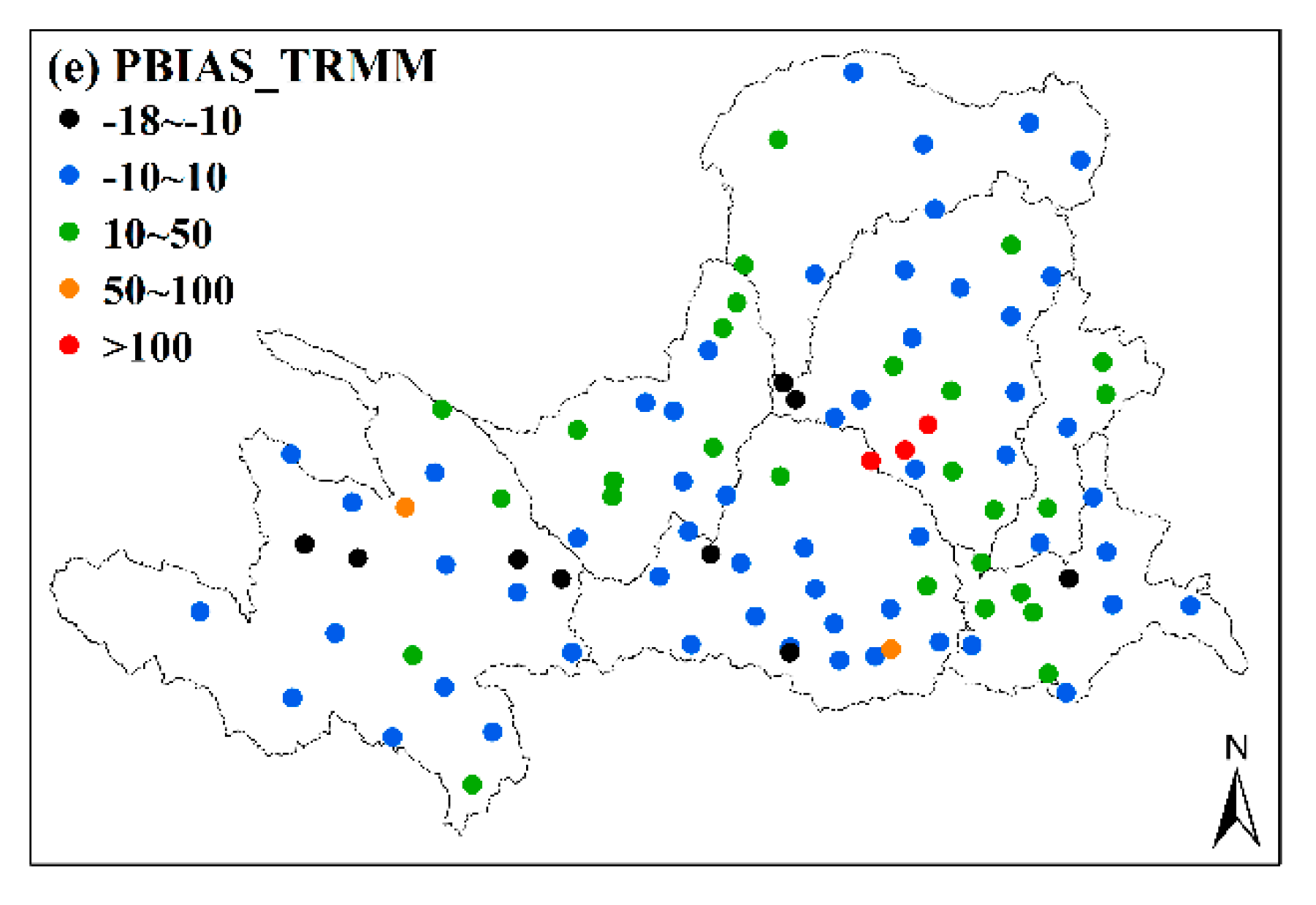
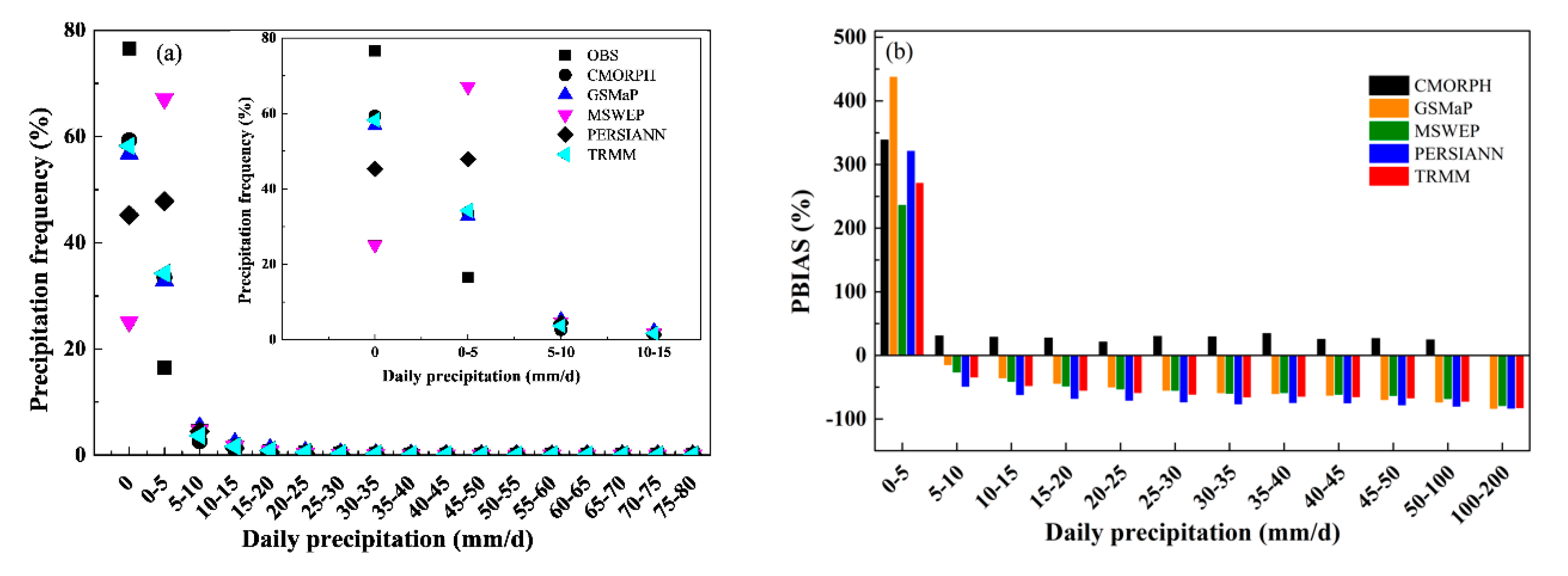


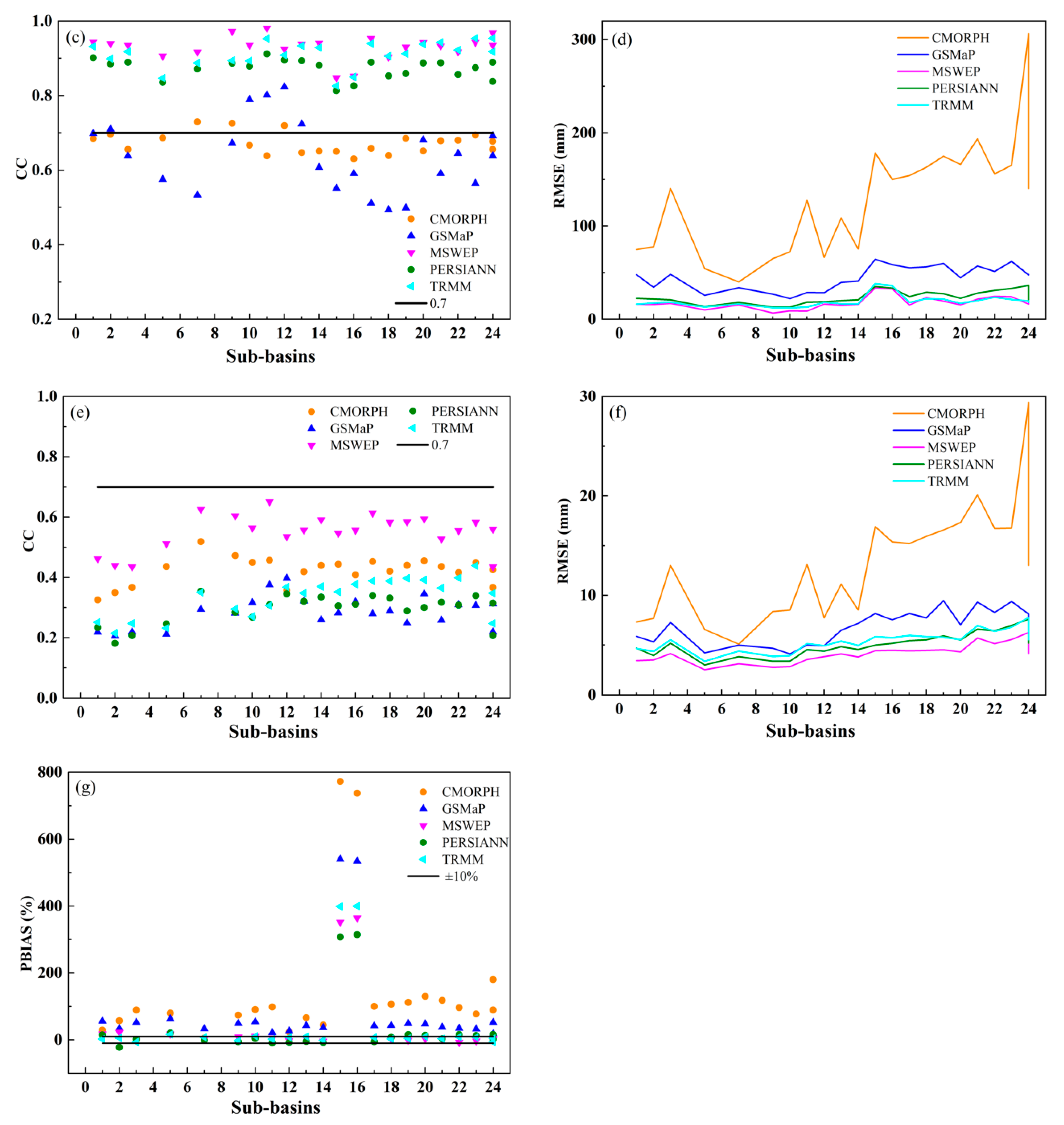
| Abbreviation | Full Name |
|---|---|
| CFSR | Climate Forecast System Reanalysis |
| CHIRP | Climate Hazards group Infrared Precipitation |
| CHIRPS | Climate Hazards group Infrared Precipitation with Stations |
| CMORPH | Climate Prediction Center MORPHing technique |
| CMORPH_BLD | CMORPH satellite-gauge blended product |
| CMORPH_CRT | CMORPH bias corrected |
| CPC | Climate Prediction Center |
| ERA-Interim | European Centre for Medium-range Weather Forecasts ReAnalysis Interim |
| GPCP | Global Precipitation Climatology Project |
| GPCP-1DD | GPCP 1-Degree Daily |
| GridSat | P derived from the Gridded Satellite |
| GSMaP_MVK | Global Satellite Mapping of Precipitation (GSMaP) Moving Vector with Kalman (MVK) |
| GSMaP_NRT | GSMaP Near Real Time |
| IMERG | Integrated Multi-satellite Retrievals for Global Precipitation Measurement |
| JRA-55 | Japanese 55-year ReAnalysis |
| MSWEP | Multi-Source Weighted-Ensemble Precipitation |
| NCEP | National Centers for Environmental Prediction |
| PERSIANN | Precipitation Estimation from Remotely Sensed Information using Artificial Neural Networks |
| PERSIANN-CCS | PERSIANN Cloud Classification System |
| PERSIANN-CDR | PERSIANN Climate Data Record |
| TMPA | TRMM Multi-satellite Precipitation Analysis |
| TRMM | Tropical Rainfall Measuring Mission |
| WFDEI-CRU | WATCH Forcing Data ERA-Interim Climatic Research Unit |
| Dataset | Time Span | Temporal Resolution | Spatial Resolution | Data Source | |
|---|---|---|---|---|---|
| Full Name | Abbreviation | ||||
| CMORPH_blended | CMORPH | 1998–present | Hourly | 0.10° | IR, SSM/I, TRMM, AMSU-B, AMSR-E, Automatic weather station in China |
| PERSIANN_CDR | PERSIANN | 1983–2017 | Daily | 0.25° | IR, TRMM 2A12, NCEP IV, GPCP |
| TMPA 3B42 V7 | TRMM | 1998–2016 | 3 hourly | 0.25° | IR, SSMIS, TMI, AMSU-B, MHS, AMSR-E, GPCP |
| GSMaP_MVK | GSMaP | 2000–2014 | Hourly | 0.10° | IR, TMI, AMSR-E, AMSR, SSMI |
| MSWEP V1.1 | MSWEP | 1979–2015 | 3 hourly | 0.25° | CPC Unified, GPCC, CMORPH, GSMaP-MVK, TRMM 3B42RT, ERA-Interim, JRA-55, CHPclim |
| CN05.1 | CN05.1 | 1961–2015 | Daily | 0.25° | Gauge |
© 2020 by the authors. Licensee MDPI, Basel, Switzerland. This article is an open access article distributed under the terms and conditions of the Creative Commons Attribution (CC BY) license (http://creativecommons.org/licenses/by/4.0/).
Share and Cite
Yang, Y.; Wu, J.; Bai, L.; Wang, B. Reliability of Gridded Precipitation Products in the Yellow River Basin, China. Remote Sens. 2020, 12, 374. https://doi.org/10.3390/rs12030374
Yang Y, Wu J, Bai L, Wang B. Reliability of Gridded Precipitation Products in the Yellow River Basin, China. Remote Sensing. 2020; 12(3):374. https://doi.org/10.3390/rs12030374
Chicago/Turabian StyleYang, Yanfen, Jing Wu, Lei Bai, and Bing Wang. 2020. "Reliability of Gridded Precipitation Products in the Yellow River Basin, China" Remote Sensing 12, no. 3: 374. https://doi.org/10.3390/rs12030374
APA StyleYang, Y., Wu, J., Bai, L., & Wang, B. (2020). Reliability of Gridded Precipitation Products in the Yellow River Basin, China. Remote Sensing, 12(3), 374. https://doi.org/10.3390/rs12030374




